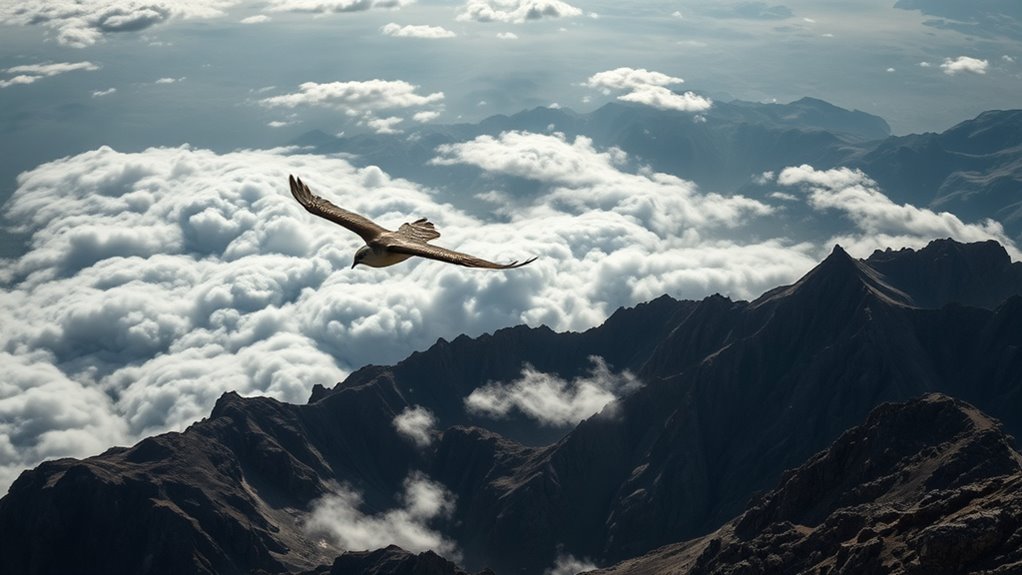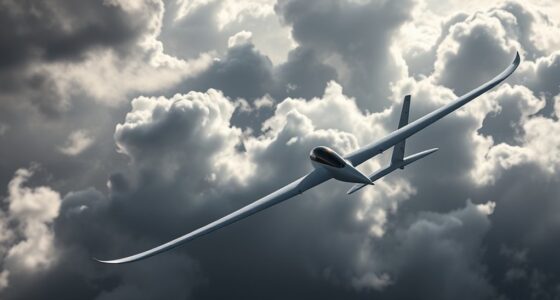Displacement soaring along mountain chains helps birds save energy by riding updrafts on ridges and valleys, allowing them to travel long distances with minimal effort. Raptors like eagles and hawks use these powerful air currents to glide efficiently, maneuvering complex terrains with skill. The physics involve rising air currents created by wind hitting mountain features, which birds exploit for lift. Keep exploring to discover how topography, weather, and conservation efforts influence these incredible migration routes.
Key Takeaways
- Mountain ridges create uplift through wind deflection, enabling birds to ride updrafts for energy-efficient displacement soaring.
- Raptors utilize ridge lift and thermals along mountain chains to extend flight range and conserve energy during migration.
- Topographical features like cliffs and rugged terrain enhance localized updrafts, aiding displacement soaring along mountain corridors.
- Birds detect weather cues and cloud patterns to locate strong updrafts, optimizing their flight paths along mountain chains.
- Climate change and urban turbulence can disrupt natural lift sources, affecting displacement soaring efficiency along mountain routes.
How Displacement Soaring Benefits Birds During Migration

Displacement soaring allows migrating birds to conserve energy by riding upward air currents along mountain chains. This natural lift is especially beneficial as urban landscapes and climate change alter traditional migration routes, making energy conservation essential. Rising temperatures and unpredictable weather patterns can disrupt wind patterns, forcing birds to expend more energy during long journeys. Mountain ridges provide reliable thermals and updrafts, helping birds navigate through increasingly challenging environments. By utilizing these air currents, they reduce fatigue and avoid unnecessary stops, which is critical when resources are scarce. This adaptation ensures they reach breeding or wintering grounds more efficiently, even amid changing climate conditions and expanding urban areas that fragment habitats. Understanding these wind patterns helps explain how displacement soaring becomes an indispensable tool for birds facing the pressures of modern environmental shifts.
Key Species That Utilize Mountain Ridge Lift

Many bird species rely on mountain ridge lift to enhance their migration efficiency, especially those that undertake long-distance journeys. Raptors like eagles, hawks, and vultures are prime examples, using thermal formation and ridge lift to conserve energy. These birds expertly navigate mountain ranges, leveraging soaring currents to stay aloft longer without flapping. Their keen bird navigation skills help them identify ideal lift zones along ridges, allowing precise positioning for displacement soaring. By exploiting mountain ridge lift, they reduce fatigue and extend their range, making migration more efficient. This adaptation is crucial for species that traverse vast terrains, as it provides a reliable and predictable energy source. Additionally, efficient energy transfer through these lift mechanisms minimizes their physical effort during long flights. Overall, key species depend on these lift mechanisms to navigate complex mountain landscapes during their migrations.
The Physics Behind Rising Air Currents and Soaring

When wind hits a mountain chain, it creates updrafts that lift air upward, making soaring possible. You’ll also notice how the Bernoulli effect influences airflow, accelerating it over ridges and generating lift. Understanding these physics principles helps explain how soaring animals and gliders take advantage of mountain-induced currents. Recognizing the symptoms of breast cancer can be crucial for early detection and treatment.
Mountain-Induced Updrafts
As prevailing winds encounter a mountain range, the air is forced to ascend along the slopes, creating powerful updrafts. These rising currents are influenced by the mountain’s geological formations, which direct airflow upward. The rugged terrain often features unique geological features that enhance uplift, such as ridges and cliffs. Mountain flora, growing in crevices and on slopes, also plays a subtle role by adding roughness and turbulence to the air, helping to sustain the updrafts. These updrafts are essential for soaring birds and gliders, providing the lift needed to stay aloft without flapping or engine power. Understanding how geological formations and local flora affect airflow helps explain the strength and consistency of mountain-induced updrafts, making them indispensable for displacement soaring techniques.
Bernoulli Effect Dynamics
The upward movement of air along mountain slopes can be explained by the Bernoulli Effect, a fundamental principle of fluid dynamics. As wind flows over the terrain, variations in airflow speed create pressure differences. When wind shear occurs, faster-moving air on one side of a slope reduces pressure, drawing air upward. Thermal uplift also interacts with this process, heating the ground and causing warm air to rise, enhancing the effect. The Bernoulli Effect causes pressure drops in areas of higher wind speed, helping generate reliable rising currents. These combined forces produce the lift needed for soaring, especially when wind shear intensifies. Understanding these dynamics allows pilots and gliders to exploit subtle pressure differences, turning the physics of Bernoulli’s principle into an effective tool for mountain soaring. Additionally, aerodynamic principles such as lift and drag play a crucial role in optimizing soaring techniques in mountainous terrain.
Techniques Birds Use to Maximize Energy Efficiency

You can see how birds take advantage of mountain winds to conserve energy while traveling. They use soaring flight strategies, like riding updrafts and gliding efficiently, to cover long distances with minimal effort. Understanding these techniques reveals how they maximize energy efficiency in challenging terrains. Additionally, some species employ predictive analytics to anticipate weather patterns and optimize their flight routes for even greater energy savings.
Exploiting Mountain Winds
Birds skillfully exploit mountain winds by soaring along air currents that flow through mountain passes and updraft zones. They capitalize on thermal collation, where warm air rises beneath cloud formation, creating lift. As the sun heats the mountain slopes, thermals develop, and birds detect these rising columns of warm air to gain altitude with minimal effort. Cloud formation often signals the presence of such thermals, guiding birds toward strong updrafts. By staying within these air currents, they conserve energy and extend their flight duration. This technique allows them to ride the mountain winds efficiently, avoiding flapping and reducing fatigue. Recognizing thermal cues and cloud patterns helps them optimize soaring, leveraging mountain winds to cover long distances with maximum energy efficiency. Regular practice of mindfulness and awareness can enhance a bird’s ability to read subtle environmental cues, much like experienced pilots or athletes improve their skills through focused training.
Soaring Flight Strategies
To maximize energy efficiency during soaring flight, birds skillfully employ a range of strategies that minimize flapping and harness natural air currents. They choose ideal soaring positions by reading wind patterns and exploiting thermals, ridge lift, or mountain waves. Consider these key techniques:
- Utilize Updrafts: Birds position themselves to catch rising air, conserving energy and extending flight time.
- Employ Avian Camouflage: Blending into the environment reduces predator threats, allowing focus on flight paths without distraction.
- Optimize Nest Site Selection: Nesting in sheltered locations ensures safer resting spots, enabling efficient recovery and preparation for future soaring endeavors.
- Adapt to Environmental Cues: Birds interpret subtle changes in weather conditions and landscape features to adapt their flight strategies for maximum efficiency. Environmental cues reflect an intricate understanding of their environment, enhancing flight efficiency while reducing unnecessary exertion.
The Role of Topography in Shaping Soaring Paths

Topography plays a pivotal role in shaping soaring paths by creating natural lift sources that gliders and birds can exploit. Mountain ridges and valleys direct airflow, producing upward currents perfect for sustained flight. However, urban turbulence caused by city landscapes can disrupt these predictable updrafts, making soaring more challenging near urban areas. Climate change also influences topography’s impact—altering wind patterns and intensifying storm activity, which can either enhance or hinder lift opportunities. As you navigate these environments, understanding how topography interacts with local weather and turbulence becomes essential. Recognizing these factors helps you optimize soaring strategies, leveraging natural features for maximum lift while remaining aware of unpredictable turbulence caused by urbanization and climate shifts. Additionally, awareness of eco-friendly practices in the region can support sustainable flight operations. This knowledge guarantees safer, more efficient flight along mountain chains.
Conservation Implications and the Future of Soaring Birds

Conservation efforts are essential to guarantee that soaring birds can continue to navigate and thrive along mountain chains, especially as their habitats face increasing threats. Urban development encroaches on key habitats, reducing available soaring corridors. Climate change alters wind patterns and thermal updrafts, disrupting migration routes. To protect these birds, focus on: 1. Implementing strict land-use policies to limit urban sprawl near critical mountain ranges. 2. Promoting habitat restoration to ensure ample nesting and resting sites. 3. Supporting research on climate change impacts to develop adaptive conservation strategies. Integrating advanced AI tools can assist in monitoring and modeling migration patterns to improve conservation efforts. Prioritizing these actions helps safeguard soaring pathways, ensuring that future generations can witness these birds utilizing natural mountain winds. Your active participation and policy support are imperative to balancing human development with the preservation of these remarkable migratory species.
Frequently Asked Questions
How Do Weather Patterns Influence Displacement Soaring Strategies?
Weather patterns greatly influence your displacement soaring strategies. You need to pay attention to weather fronts, as they often create lift or turbulence that can help or hinder your flight. Temperature gradients, especially near fronts, generate thermal activity that you can use to gain altitude. By understanding these patterns, you can plan your routes more effectively, taking advantage of rising air and avoiding turbulent areas for a smoother, more efficient soaring experience.
Can Non-Avian Species Utilize Mountain Ridge Lift for Movement?
You might wonder if non-avian species can use mountain ridge lift for movement. While birds and gliders rely on thermal currents and ridge lift to soar, non-avian animals generally don’t harness these atmospheric features. However, certain insects or gliding creatures may use wind currents near mountain ridges for short-distance travel or to conserve energy, but they don’t actively utilize thermal currents or ridge lift like birds do.
What Are the Historical Changes in Soaring Bird Migration Routes?
You might notice how migration corridors have shifted over time, influenced by habitat changes and climate shifts. Historically, birds adjusted their routes to follow favorable conditions, sometimes along mountain chains, sometimes avoiding them. These habitat shifts caused alterations in migration pathways, making some routes more direct or extended. You see, environmental changes constantly shape these routes, prompting birds to adapt their soaring behaviors, ensuring successful migration despite evolving landscapes.
How Do Urban Landscapes Affect Displacement Soaring Along Mountain Chains?
You might notice that urban landscapes create barriers that disrupt soaring bird migration. Skyscraper effects, like wind tunnels and turbulence, can either hinder or redirect their flight paths. These urban barriers force birds to adapt, often leading to altered routes or increased energy expenditure. By understanding these impacts, you can better appreciate how cities influence natural migration and consider ways to make urban areas more bird-friendly.
Are There Differences in Soaring Techniques Between Juvenile and Adult Birds?
You’ll find that juvenile flight differs drastically from adult aerodynamics, like comparing a fledgling’s clumsy dance to a master’s ballet. Juvenile birds often rely on basic soaring techniques, struggling with wind currents, while adults expertly harness thermals and wind shifts. Their experience sharpens their skills, allowing adults to soar effortlessly along mountain chains. So, yes, their techniques change markedly as they grow, making flying seem almost magical.
Conclusion
You’ve seen how mountain chains create powerful lift, with some birds soaring for hours, covering up to 500 kilometers in a single day. These natural currents boost their energy and survival chances. As climate change alters topography and wind patterns, understanding and protecting these soaring corridors become even more essential. By safeguarding these critical pathways, you help ensure that these incredible birds continue to thrive, harnessing the mountain’s lift for generations to come.
With a heart that soars as high as the skies, Aria, affectionately known as “Skylark,” is the driving force behind Soaring Skyways. Her journey into the gliding world began as a young dreamer gazing up at the soaring birds, yearning to experience the weightlessness and freedom they embodied. With years of experience both in the cockpit and behind the scenes, Aria’s commitment to the gliding community is unwavering.









